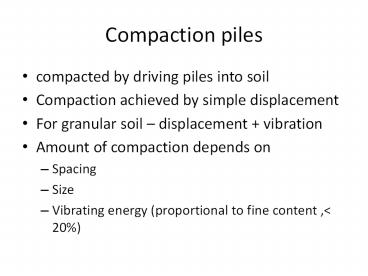Compaction piles - PowerPoint PPT Presentation
Title:
Compaction piles
Description:
These piles are used for improving the Geo technical engineering proprties – PowerPoint PPT presentation
Number of Views:2326
Title: Compaction piles
1
Compaction piles
- compacted by driving piles into soil
- Compaction achieved by simple displacement
- For granular soil displacement vibration
- Amount of compaction depends on
- Spacing
- Size
- Vibrating energy (proportional to fine content ,lt
20)
2
- Compaction piles
- Structural piles (timber / pre-cast/ concrete)
- Fill material pile (Sand piles, gravel)
- Structural piles densifies loose soil
- Sand piles
- installed by driving a hollow steel mandrel with
a false bottom to the required depth - fill the mandrel with sand
- applying air pressure to the top of the sand
column - Withdraw the mandrel
- Pore water pressure increases
3
- Design based on
- stability of the sand column
- the piles and soil are subjected to equal
vertical deformation - soils of low permeability below the water table-
sand piles as drains - A well-compacted layer of soil is placed on top
of the sand piles to obtain a better load
concentration on the piles by arching
4
- Vibro-composer method
- driving a casing to the required depth by means
of a vibrator. - A quantity of sand is then placed in the pipe
which is partially withdrawn as compressed air is
blown down the casing - Next the pipe is vibrated downwards to compact
the sand pile. - The process is repeated until the ground surface
is reached
5
Vibro composer sand piles
6
Gravel compaction piles
- a tube closed by a plug of gravel (or zero slump
concrete) is driven into the ground by means of a
drop-hammer striking the plug - the soil is compacted radially around the tube
while driving - tube _at_ design depth an expanded base is formed by
ramming with a high-energy hammer - tube is then raised in lifts gravel is driven
from the tube so forming a continuous pile of
compacted gravel
7
(No Transcript)
8
Concrete columns
- support structures on weak cohesive, organic or
loose granular soils and fills - vibrator which contains a special hollow shoe
that houses a tremie pipe down to which concrete
is pumped - pipe is connected by hose to a trailer-mounted
concrete pump - Pipe pumps concrete under pressure
- Vibrations _at_ 3000Hz
9
- the vibrator is withdrawn about a metre while
pressurized concrete is tremied in at the toe - The vibrator is then driven back to the original
depth to create a bulbous bearing end - withdrawn at a slower speed than the pumping flow
so as to maintain pressure in the concrete column - Once grade level is reached the concrete is shut
off - the vibrator is briefly re-immersed in the
concrete to finish off the column
10
(No Transcript)
11
Dynamic compaction
- repeatedly impacting the ground surface by
dropping a pounder from a given height from a
heavy duty crane - _at_ of one blow every 13 mins
- the distances between the centres of impact
frequently ranging between 4 and 20 m - set out on a grid pattern
- The energy per blow is chosen to maximize
penetration of the resultant stress impulses - Densify a wide range of soils from organic and
silty clay to loosely packed coarse-grained soil
sand fills
12
- The energy required to achieve a given result
increases with the amount of fines in the ratio
13 when going from coarse gravel to silty clay. - Compactor with Wt 200t n height 40 m can
compact 50-60m of clayey silt - Vibration frequency is around 5 Hz, and usually
lower than 12 Hz - The threshold vibration velocity above which
damage may occur in buildings is normally taken
at 50 mm/s - extensive site investigation must be carried out
prior to the commencement of dynamic compaction
13
Dynamic compaction
14
- Dynamic compaction is carried out in several
phases - spacing between the points of impact is large in
the first pass and is reduced successively in
subsequent ones - The modulus of deformation of the soil maybe
increased by two to ten times - the depth of the imprint does not exceed half the
width of the pounding mass - must have three or four types of tamping weights
available on site.
15
- After each pass the craters formed in the ground
by tamping are filled with soil (ideally
well-graded granular) before the next pass - Finally ground is given a final ironing pass in
which the weight is dropped from 1 to 2 m at
spacings smaller than the width of the weigh - saturated or partially saturated soils and soft
peaty or organic deposits are not subjected
to direct dynamic compaction - For soft clays use vertical drains to result in
compaction - Small machine (a large hydraulic pile hammer
mounted on a crawler crane) consolidates upto 4m
for small constructions































